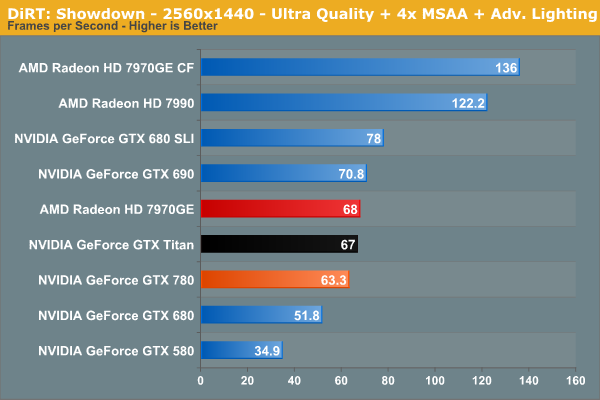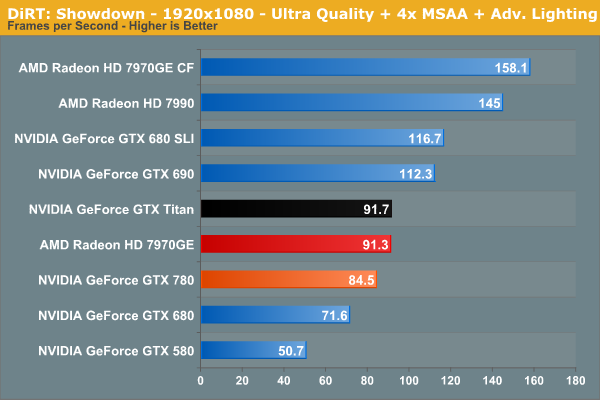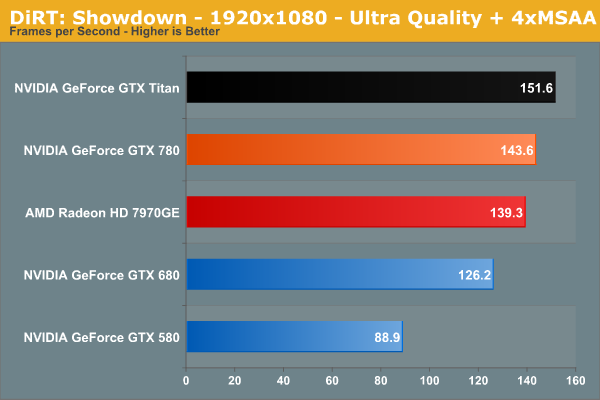NVIDIA GeForce GTX 780 Review: The New High End
by Ryan Smith on May 23, 2013 9:00 AM ESTDiRT: Showdown
As always, starting off our benchmark collection is our racing benchmark, DiRT: Showdown. DiRT: Showdown is based on the latest iteration of Codemasters’ EGO engine, which has continually evolved over the years to add more advanced rendering features. It was one of the first games to implement tessellation, and also one of the first games to implement a DirectCompute based forward-rendering compatible lighting system. At the same time as Codemasters is by far the most prevalent PC racing developers, it’s also a good proxy for some of the other racing games on the market like F1 and GRID.




DiRT: Showdown’s lighting system continues to befuddle us at times. Though GK10x Kepler parts generally have mediocre compute performance in pure compute tasks, NVIDIA’s DirectCompute performance has otherwise proven to be appropriately fast, except in the case of DiRT. The fact of the matter is that DiRT is easy enough to run even with its advanced lighting system that there’s no reason not to use it on a card like the GTX 780 at any single-monitor resolution, but doing so does put the GTX 780 in a bad light relative to AMD’s best cards. Nor does this put GK110 in a particularly good light, as its compute enhancements don’t bring it much of an advantage here beyond what the larger number of shaders affords.
Like Titan before it, the GTX 780 falls slightly behind AMD’s Radeon HD 7970 GHz Edition, the only such benchmark where this occurs. The end result being that the GTX 780 trails the 7970GE by about 7%, and the GTX Titan by 6%. Otherwise we’ve seen Titan (and will see GTX 780) do much better in virtually every other benchmark.










155 Comments
View All Comments
SymphonyX7 - Thursday, May 23, 2013 - link
*mildly/narrowly trailing the GTX 680chizow - Thursday, May 23, 2013 - link
AMD released some significant driver updates in ~Oct 2012, branded "Never Settle" drivers that did boost GCN performance significantly, ~10-20% in some cases where they were clearly deficient relative to Nvidia parts. It was enough to make up the difference in a lot of cases or extend the lead to where the GE is generally faster than the 680.On the flipside, some of AMD's performance claims, particularly with CF have come under fire due to concerns about microstutter and frame latency, ie. the ongoing runtframe saga.
Vayra - Thursday, May 23, 2013 - link
Drivers possibly?kallogan - Thursday, May 23, 2013 - link
High end overpriced gpu again ! Next !wumpus - Thursday, May 23, 2013 - link
Except that the 780 is nothing more than a Titan with even more cuda performance disabled. Presumably, they are expecting to get Titan sales to people interested in GPU computing, if only for geeklust/boasting.wumpus - Thursday, May 23, 2013 - link
My above comment was supposed to be a reply. Ignore/delete if possible.ifrit39 - Thursday, May 23, 2013 - link
Shadow Play is the most interesting news here. It costs a not-insignificant amount of money to buy a decent capture card that will record HD video. This is a great alternative as it requires no extra hardware and has little CPU/GPU overhead. Anything that ends up on the net will be compressed by youtube or other service anyway. I can't wait to remove fraps and install shadow play.ahamling27 - Saturday, May 25, 2013 - link
Fraps isn't the best, but they somehow have the market cornered. Look up Bandicam, I use it exclusively and I get great captures at a fraction the size. Plus they aren't cut up into 4 gig files. It has at least 15x more customization like putting watermarks in your capture or if you do like to segment your files you can have it do that at any size or time length you want. Plus you can record two sound sources at once, like your game and mic, or your game and whatever voice chat software you use.Anyway, I probably sound like I work for them now, but I can assure you I don't. This Shadow Play feature is definitely piquing my interest. If it's implemented wisely, it might just shut all the other software solutions down.
garadante - Thursday, May 23, 2013 - link
There were two things that instantly made me dislike this card, much as I've liked Nvidia in the past: completely disabling the compute performance down to 600 series levels which was the reason I was more forgiving towards AMD in the 600/7000 series generation, and that they've priced this card at $650. If I remember correctly, the 680 was priced at $500-550 at launch, and that itself was hard to stomach as it was and still is widely believed GK104 was meant to be their mid-range chip. This 780 is more like what I imagined the 680 having been and if it launched at that price point, I'd be more forgiving.As it is... I'm very much rooting for AMD. I hope with these new hires, of which Anandtech even has an article of their new dream team or some such, that AMD can become competitive. Hopefully the experience developers get with their kind-of-funky architecture with the new consoles, however underwhelming they are, brings software on the PC both better multithreaded programming and performance, and better programming and performance to take advantage of AMD's module scheme. Intel and Nvidia both need some competition so we can get this computer hardware industry a bit less stagnated and better for the consumer.
EJS1980 - Tuesday, May 28, 2013 - link
The 680 was $500 at launch, and was the main reason why AMD received so much flak for their 7970 pricing. At the time it launched, the 680 blew the 7970 away in terms of gaming performance, which was thee reason AMD had to respond with across the board price drops on the 7950/70, even though it took them a few months.